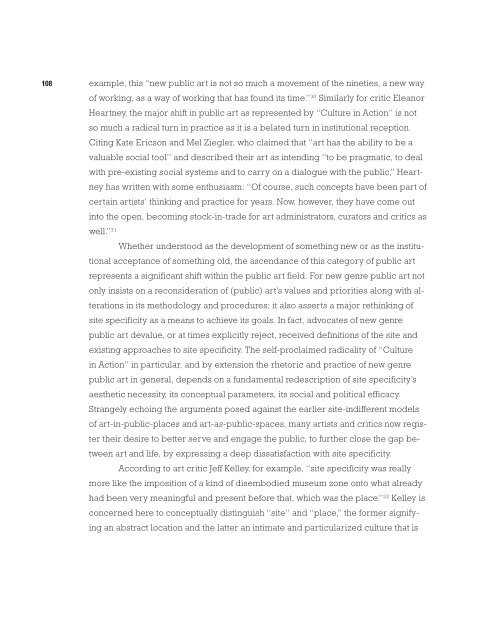ONE PLACE AFTER ANOTHER - Monoskop
ONE PLACE AFTER ANOTHER - Monoskop
ONE PLACE AFTER ANOTHER - Monoskop
Create successful ePaper yourself
Turn your PDF publications into a flip-book with our unique Google optimized e-Paper software.
108<br />
example, this “new public art is not so much a movement of the nineties, a new way<br />
of working, as a way of working that has found its time.” 30 Similarly for critic Eleanor<br />
Heartney, the major shift in public art as represented by “Culture in Action” is not<br />
so much a radical turn in practice as it is a belated turn in institutional reception.<br />
Citing Kate Ericson and Mel Ziegler, who claimed that “art has the ability to be a<br />
valuable social tool” and described their art as intending “to be pragmatic, to deal<br />
with pre-existing social systems and to carry on a dialogue with the public,” Heartney<br />
has written with some enthusiasm: “Of course, such concepts have been part of<br />
certain artists’ thinking and practice for years. Now, however, they have come out<br />
into the open, becoming stock-in-trade for art administrators, curators and critics as<br />
well.” 31<br />
Whether understood as the development of something new or as the institutional<br />
acceptance of something old, the ascendance of this category of public art<br />
represents a significant shift within the public art field. For new genre public art not<br />
only insists on a reconsideration of (public) art’s values and priorities along with alterations<br />
in its methodology and procedures; it also asserts a major rethinking of<br />
site specificity as a means to achieve its goals. In fact, advocates of new genre<br />
public art devalue, or at times explicitly reject, received definitions of the site and<br />
existing approaches to site specificity. The self-proclaimed radicality of “Culture<br />
in Action” in particular, and by extension the rhetoric and practice of new genre<br />
public art in general, depends on a fundamental redescription of site specificity’s<br />
aesthetic necessity, its conceptual parameters, its social and political efficacy.<br />
Strangely echoing the arguments posed against the earlier site-indifferent models<br />
of art-in-public-places and art-as-public-spaces, many artists and critics now register<br />
their desire to better serve and engage the public, to further close the gap between<br />
art and life, by expressing a deep dissatisfaction with site specificity.<br />
According to art critic Jeff Kelley, for example, “site specificity was really<br />
more like the imposition of a kind of disembodied museum zone onto what already<br />
had been very meaningful and present before that, which was the place.” 32 Kelley is<br />
concerned here to conceptually distinguish “site” and “place,” the former signifying<br />
an abstract location and the latter an intimate and particularized culture that is

















